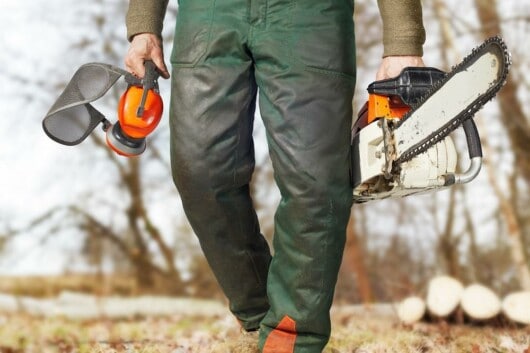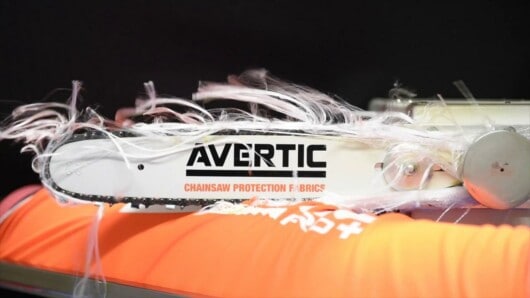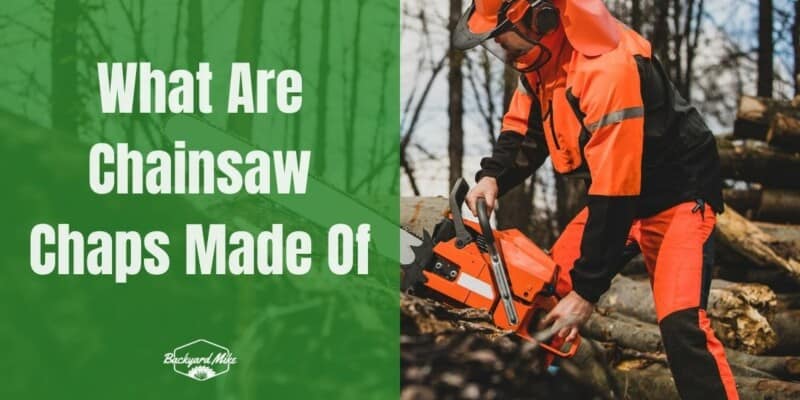Have you heard the saying “prevention is better than cure”? It is rightfully said that it is better to prevent the accident than having to the wounds. A chainsaw is extremely dangerous to operate, and you have to wear the necessary safety gear whenever operating it. The gear includes many pieces of equipment, including chainsaw chaps. Now comes the important question, what are chainsaw chaps made of?
Chainsaw chaps are made of a rugged shell of denier polyester treated with a water-resistant coating. A chainsaw chap will help keep the injury damage to a minimum while also giving you enough freedom to move. In this article, you’ll get to know all about chainsaw chaps, what are chainsaw chaps made of, the advantage and disadvantages of the material used, and more.
Significance of chainsaw chaps for user protection
A chainsaw is incredibly dangerous, no matter how experienced you are, even a small slip up could be fatal. Even the most careful users could face kickbacks or slips, bringing the chain into contact with the body. When chainsaw injuries happen, a lot of them are leg injuries. A pair of chainsaw chaps will keep your legs intact while also offering enough freedom of movement.

They will cover the front of the legs and consist of rugged material like denier polyester. This material will prevent the blade from cutting through the chaps and into your leg. The chaps also feature Kevlar and ballistic cores, serving as an extra stopgap for clogging the chainsaw. Further, the chain will come to a stop if by chance the blade breaches the outer layer of the chaps.
What are chainsaw chaps made of?
A standard chainsaw chap is made using a rugged shell of denier polyester, which is typically treated with a water-resistant coating. The shell will cover a core composed of either Kevlar, ballistic nylon, or Tek warp. These materials are laid out in layers. If a chainsaw contacts the trousers, the outer layer will be cut through, but the inner layers will be drawn out. It’ll wrap around the chainsaw’s drive sprocket and lock it. It’ll then halt the chain and limit the damage to the operator’s leg. The length of the chaps and the number of layers will define the safety class.
During accidents, the fabric could get pulled out of the upper and lower seams and wrapped around the sprocket. The chaps should be slightly baggy, but not too baggy such that there is given. This will prevent the chain from pulling your leg into the chainsaw. Instead, the baggy fabric will get pulled out and into the chain, ultimately stopping the chainsaw. After stopping the chainsaw, the damaged trousers need to be scrapped as they’ve done their job.

The material used for the chainsaw chaps will determine the safety and comfort of the chaps. Further, it needs to be made using durable and high-quality material, including a core with multiple layers for added protection. The comfortable chaps will come with soft inner linings with an ergonomic shape. Check whether the chainsaw chaps you’re wearing are suitable for using with gas-powered or electric chainsaws, this will prevent the prospect of injuries. Here are some of the different materials used for the production of chainsaw chaps –
Kevlar
It is a strong, thin, lightweight, and heat-resistant fiber discovered in 1965. It is often used as an alternative to steel, usually in racing tires. However, now they’ve started to be used in clothing like chainsaw chaps as they’re superior to the traditional chap material.
PVC
It is a synthetic plastic coating that will allow the chain to repel oil and water. It is a handy material that turns out to be very useful when working outdoors with the chainsaw.
Nylon
This synthetic polymer is extremely flexible and stretchy, making it effortless to wrap around the drive sprocket. Thereby, it will prevent the chainsaw chain from running and keep you safe.
Polyester
This is a chemically derived material made from water, petroleum, and air. The combination makes the fiber incredibly useful for chainsaw chaps as short/long as possible. Similar to nylon, polyester can be used to wrap around the drive sprocket and prevent the chainsaw from running.
Tek warp
Tek warp is a protective material having cut-retardant properties. This means that Tek warp cannot be sliced by the chain blades easily. Further, it is designed for pulling apart as it clogs the sprocket system of the chainsaw.
Different protective layers of the chainsaw chaps
While the chaps are made using different materials, what makes them sturdy is the multiple layers of protective fabric. These protective layers will provide safety and durability, as they’ll protect your legs from potential injuries.
Primary fabric
You must use chainsaw chaps that are made of strong fabrics, as they can withstand the tough environment. Otherwise, the chaps might wear out easily, and you’ll need to replace the material by spending extra money. Most manufacturers today use tough fabrics like nylon-based material or denier polyester for making chainsaw chaps.
Protective fibers
The chaps aren’t actually for shielding against cutting, but the multiple layers of protective fibers will slow down the chain. The chainsaw chaps will slow down the chain and protect you. These protective fibers are made using heavy-duty materials like Kevlar, ballistic grade nylon, and more.
Outer coating
The majority of chainsaw chaps today come with PVC coating on the outside. This is done because of many reasons like PVC as it makes the chaps slippery. This will, in turn, lead to the blade catching the outer material. Thus, it’ll prevent any accidental injuries. PVC coating will make the chaps stain, oil, and water-resistant.
Buckles and straps
No matter what material you go for, until and unless they’re able to stay securely in place. For that, you’ll need to purchase quality straps and buckles. This way, you’ll be able to keep the chainsaw chaps stay right over the place for protection. Most straps are made using a similar material to spandex. This stretches and will not break with ease. The buckles, on the other hand, are made using heavy-duty polyester plastic or acetyl Delran.
When talking about the thickness of the materials used for chainsaw chaps, you need to consider the different layers of fabric used for the chaps. The more the fabric layers, the more safety, and protection you’ll receive. In general, chainsaw chaps having more layers will mean having a higher chance of jamming the chainsaw chain. Here, Denier is the unit of measurement used for defining how thick individual fiber threats are. Depending on the different brands of chainsaw chaps, the chaps generally range between 400 and 1000 deniers.
Advantages of using chainsaw chaps
- No snagging or hazard during chipping or other tasks. The chaps are worn at the start of the day and the jobs can be easily performed throughout the day.
- The fabrics are manufactured in a way that they fit correctly.
- The fabrics in the chainsaw chaps will remain fully functional if you regularly wash and maintain the chaps.
- A pair of chainsaw chaps is all you need for the clothing. Less layering of clothing will mean better movement.
Disadvantages of using chainsaw chaps
- Will cause discomfort in certain jobs like climbing due to snagging hazards.
- More downtime is needed, especially if you have to take off the chaps multiple times a day
- Lack of maintenance and improper cleaning will lead to premature wearing out.
- The chaps will feel hotter during warm weather and offer less freedom of movement if you’re choosing chaps will a lot of layering.
Safety standards to consider with the chainsaw chaps
You should ensure that you’re choosing a pair of chaps that can handle the maximum chain speed of your chainsaw. Generally, chainsaw chaps use a fabric class rating between 0 and 3. The Class 0 fabric is best suited for chainsaws having a maximum speed of 16 m/s. Class 1 can handle maximum speeds of up to 20 m/s. Thicker chainsaw chaps having a class 2 rating can handle chainsaws with a speed of 24 m/s.
Meanwhile, Class 3 chaps can handle chainsaw speeds of up to 28 m/s. The speed of the chainsaw will be mentioned in the user manual of the chainsaw. Remember that chainsaw chaps having a higher rating will be thicker and feel hotter. It’ll make sense if you can get chainsaw chaps that are adequate for the speed of your chainsaw. It won’t make sense to go for the highest rating, as it’ll give you more trouble than benefits.
The chainsaw chaps are regulated by Underwriter Laboratories and OSHA recommends all the workers and backyard users to use chainsaw chaps. In fact, OSHA requires that all chainsaw operators should wear chainsaw chaps, eye protection, head protection, steel-toed boots, and eye protection.
Maintenance for chainsaw chaps
When it comes to maintaining your chaps, focus on two things – cleaning and repair. Ensure that you’re repairing any small cuts or holes in the outer layers of your chainsaw chaps. You can use products like Seam Grip for repairing the damage to the nylon shell. This will create an abrasion-proof and waterproof patch, safeguarding your Kevlar pad from any contaminants.
When it comes to cleaning the chainsaw chaps, you should regularly wash them manually and hang them outside for drying. However, if the manufacturer has provided specific techniques for washing or the preferred commercial detergents, follow those instructions carefully. Otherwise, you can clean them as you would clean a pair of jeans and then hang them outside for drying.
Conclusion
Thank you for reading. Hopefully, now you’re more aware of what are chainsaw chaps made of and the protective layers. The significance of chainsaw chaps can be summed up by the fact that OSHA recommends every chainsaw user wear the chaps when operating a chainsaw. The rugged and durable chainsaw chaps can be the difference between a minor scratch and a serious injury.


